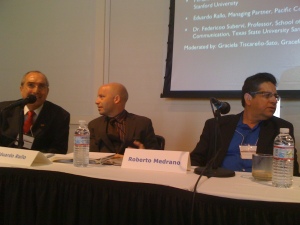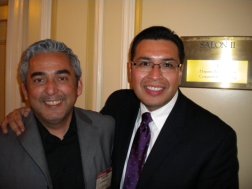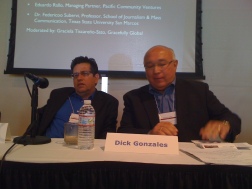Didn’t Make the Summit? Here’s a sample of what you missed
May 27, 2010 Leave a comment
Insightful Panelists answering Relevant Questions with Prescriptive, Actionable, Answers

At the Leadership Summit, five prominent panelists participated in the plenary session titled “Latinos Leading with a 2020 Vision”. Below are the questions the moderator and the audience asked of the panelists.
If you want access to their answers, check back here for the video in a few weeks. You’ll see a few of these questions get answered.
And…keep an eye out for next year’s Silicon Valley Latino Leadership Summit. By attending, you’ll be able to ask your own questions directly to the published authors, thought leaders, venture capital partners and corporate executives on next year’s panel!
Getting Access to Capital
- How do I, as a person who knows she wants to be an entrepreneur, best position myself to attract capital for my venture? Must I be in a specific industry? Have specific corporate experience?
- What types of ideas/industries/trends are attracting your attention right now as a VC?
- When you evaluate business plans from entrepreneurs, what are the top two things you look for initially to determine if you’re going to invite the person/team in to pitch in person? What are your screening criteria?
- Tell us what an instant reject looks like – the kind of pitch that will never get off the ground in your eyes. What are the top things to avoid doing when seeking an audience with a venture capital firm?
- Pacific Community Ventures (PCV) describes itself as a “community-focused” venture capital fund. Can you please explain what that means? How does it impact the types of ventures you’ll seriously think about funding?
- What is the one thing I need to do to get 20 minutes in front of a venture capital partner?
- How do I become a venture capitalist? What are the key steps to entering the VC world as a VC partner?
Becoming an Entrepreneur
- What are the key elements you would advise business students to pursue who someday want to be entrepreneurs?
- Your career path is unique in that you finished your MBA at Harvard Business School then went straight into entrepreneurship and then into a venture capital setting. You didn’t take the corporate path. Can you please share with us how that came about and what the benefits of this path have been? Would you advise others in school today to do what you did?
- You made a transition from Google executive to entrepreneur. How did you know the time was right to make this change?
Retention Strategies
- Can you provide insight into one or two best practices to improve retention of valuable Latino consumers?
- We have great representation from several large Bay Area companies here today: Kaiser Permanente, Intel, Cisco Systems, Ernst & Young Financial and others. What would you say is the one thing these companies must do to attract the small handful of young Latinos and Latinas with undergraduate and graduate business degrees?
- U.S. Census Bureau data stated today’s 44 million U.S. Hispanics are expected to reach 100 million by 2050. A recent article in Diversity MBA Magazine titled “Recruiting Hispanic Professionals” posed an interesting question: if the Hispanic population is booming, why has it been so difficult for corporations to attract, hire and retain Hispanic professionals? Did you see any successful or not-so-successful strategies while at Safeway?
- Do employee affinity groups play a key role in customer retention?
- Does the desire of many Latinos to become entrepreneurs, leaving corporate America and do our own thing, play into the difficulty of retaining Latino talent?
Leadership in Education
You have undergraduate and graduate degrees in electrical engineering, plus an MBA.
- Can you please share with us WHY you decided on this particular combination of technical and business degrees?
- What lessons, from your educational experience, can we take back to our communities as we mentor young kids trying to figure out what to study and why? They have obviously served you well as an international expert in the field of Internet security AND as advisor to Presidents Clinton and Bush. J
- For those in the room that want to serve our nation as a high-level advisor such as you are doing, what advice would you give to us about becoming visible to the right people? How did it happen for you?
- At the Ph.D. Project conference in Chicago, an organization that recruits business professionals into doctoral programs so that we can have more business school professors of color, we learned that there less than 200 Latino professors in America’s business schools….of 26,000 faculty across the nation! We make up 7% of the white collar workforce according to NSHMBAs research department. As a group, we are severely underrepresented in higher education and corporate America, two American institutions of great influence.
- Why are these faculty and corporate numbers so low and how can we take intentional steps to increase these numbers?
Positive Images of Latinos in Mainstream Media (or lack thereof)
- How can we increase our exposure in the mainstream media if we’re not at the table when programming decisions are being made?
- What are the media doing to help get Latinos get the critical air time needed for successful runs for office?



